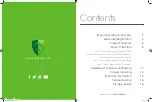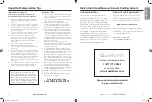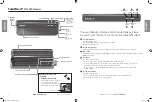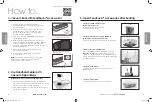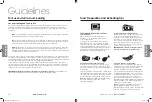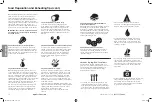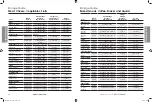
G
U
IDE
LI
N
ES
12
13
www.FoodSaver.com
Customer Service:
1 (877) 777-8042
When freezing vegetables, it is best to pre-freeze
them for 1-2 hours or until solidly frozen. To
freeze vegetables in individual servings, first
place on a baking sheet and spread them out so
they are not touching. This prevents them from
freezing together in a block. Once they are frozen,
remove from baking sheet and vacuum seal
vegetables in a FoodSaver
®
Bag. After they have
been vacuum sealed, return them to the freezer.
IMPORTANT: Due to the risk of anaerobic bacteria,
Fresh mushrooms, onions and garlic should never
be vacuum sealed.
Preparation Guidelines for Leafy Vegetables:
For best results, use a canister to store leafy
vegetables. First wash the vegetables, and then
dry with a towel or salad spinner. After they are
dried, put them in a canister and vacuum seal as
normal. Store in refrigerator.
Preparation Guidelines for Fruits:
When freezing soft fruits or berries, it is best
to pre-freeze them for 1-2 hours or until solidly
frozen. To freeze fruit in individual servings, first
place on a baking sheet and spread them out so
they are not touching. This prevents them from
freezing together in a block. Once they are frozen,
remove from baking sheet and vacuum seal
fruit in a FoodSaver
®
Bag. After they have been
vacuum sealed, return them to the freezer.
You can vacuum seal portions for baking, or in
your favorite combinations for easy fruit salad
all year round. If storing in the refrigerator, we
recommend using a FoodSaver
®
Canister.
Preparation Guidelines for Baked Goods:
To vacuum seal soft or airy baked goods, we
recommend using a FoodSaver
®
Canister so they
will hold their shape. If using a bag, pre-freeze
for 1-2 hours or until solidly frozen. To save time,
make cookie dough, pie shells, whole pies, or mix
dry ingredients in advance and vacuum seal for
later use.
Preparation Guidelines for Coffee and Powdery Foods:
To prevent food particles from being drawn into
vacuum pump, place a coffee filter or paper towel
at top of bag or canister before vacuum sealing.
You can also place the food in its original bag
inside a FoodSaver
®
Bag, or use a FoodSaver
®
Universal Lid with the original container to
vacuum seal.
Preparation Guidelines for Liquids:
Before you vacuum seal liquids such as soup stock,
pre-freeze in a casserole dish, loaf pan or ice cube
tray until solid. Remove frozen liquid from pan and
vacuum seal in a FoodSaver
®
Bag. You can stack
these “frozen bricks” in your freezer. When you’re
ready to use, just cut corner of bag and place in a
dish in microwave or drop into water at a low simmer,
below 170°F (75°C).
To vacuum seal non-carbonated bottled liquids, you
can use a FoodSaver
®
Bottle Stopper with the original
container. Remember to leave at least one inch of
room between contents and bottom
of Bottle Stopper. You can re-seal bottles after
each use.
Food Preparation and Reheating Tips (cont.)
G
U
IDE
LIN
ES
Preparation Guidelines for Make-ahead Meals,
Leftovers and Sandwiches:
Efficiently store your make-ahead meals, leftovers
and sandwiches in the stackable, lightweight
FoodSaver
®
containers. They are microwaveable,
top rack dishwasher safe and come with a custom
adaptor. The lightweight containers will be ready
to head off to the office, to school or the great
outdoors whenever you are!
Preparation Guidelines for Snack Foods:
Your snack foods will maintain their freshness
longer when you vacuum seal them. For best
results, use a FoodSaver
®
Canister for crushable
items like crackers.
Vacuum Sealing Non-Food Items
The FoodSaver
®
Vacuum Sealing System also
protects non-food items from oxidation, corrosion
and moisture. Simply follow the directions to
vacuum seal items using FoodSaver
®
Bags,
Canisters and Accessories.
• To vacuum seal silver, wrap fork tines in soft
cushioning material, such as a paper towel, to
avoid puncturing bag, and seal as normal. Your
silver will be clean, fresh and untarnished right
when you need it for your next dinner gathering.
• Your FoodSaver
®
Bags are ideal for outdoor
excursions. For camping and hiking, keep your
matches, maps and food dry and compact.
• To have fresh water for drinking, simply fill a
FoodSaver
®
Bag with ice, vacuum seal it, and
when needed, let the ice pack melt. You can
trim the corner off the bag to make a spout for
drinking or pouring.
• If you’re going sailing or boating, you can vacuum
seal your food, extra batteries, memory cards,
cash, identification cards, boating license and a
dry change of clothes. Just remember to bring
scissors or a knife to open the bags when you
need them!
• To keep emergency kits safe and dry, vacuum seal
flares, batteries, flashlights, matches, candles,
first aid kits, extra food and other necessities.
Your emergency items will stay dry and organized
in your home, car, boat or RV.
FM2000 Series_21EM1.indd 15-16
FM2000 Series_21EM1.indd 15-16
6/23/21 09:49
6/23/21 09:49


